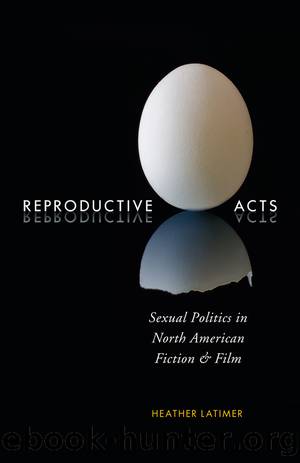Reproductive Acts by Latimer Heather;

Author:Latimer, Heather;
Language: eng
Format: epub
Publisher: McGill-Queen's University Press
Mavis
Of all the Convent women, Mavis is the most obviously maternal in that she has had five children. Much like Sethe, the main character in Beloved, Mavis has killed some of her children, and her narrative often focuses on how she deals with her grief over their deaths. Unlike Sethe, Mavis does not kill her children intentionally, but by accident. Her baby twins, Merle and Pearl, suffocate in a hot car while Mavis grocery shops for her abusive husbandâs dinner. Soon after their deaths Mavis begins to suspect that her husband, who brutalizes, rapes, and degrades her, is trying to enlist her other children in a plan to kill her. She therefore steals her husbandâs car and runs away from her home in Maryland. At first she goes to her motherâs house, but when her mother phones her husband to tell on her, she ârealizes that her own mother, like her older children, will conspire against her because of the strength of the social norm that children and women need to have a father and a husband.â65 She leaves her motherâs house and sets out alone for California. Along the way she runs out of gas and ends up at the Convent, where she stays for the rest of the novel, except for brief stints to spy on her children.
All of the Convent womenâs stories involve violence and desertion of some type â Consolata was raped as a child, Gigi is traumatized by witnessing the brutal death of a boy at a Black Panther demonstration, Seneca has been sexually abused, and Pallas is pregnant, possibly from a gang-rape. Mavisâs story, however, is especially disturbing because, like Barbeâs story, it involves the taboo of infanticide and, also like Barbeâs story, shows us a mother who feels sadness without guilt about her actions. When reporters come to Mavisâs house to interview her after Merleâs and Pearlâs deaths, for instance, she refuses to accept a journalistâs falsely sympathetic statement, âthis must be terrible for you,â by replying âYes, mâam. Itâs terrible for all of us.â Implicating her abusive husband and dysfunctional family in the twinâs deaths, Mavis refuses sole responsibility for a situation that would be easy to write off as a case of motherly neglect. When the journalist pushes Mavis to admit she acted wrongly, and that she must have been in the grocery store for longer than she remembers, Mavis refuses these implications: âI wasnât expecting no danger.â66 Keeping to herself that the real danger for her, and her children, lies with her husband, Mavis is unable to explain to the reporter what the consequences might have been for her had she not gone to the grocery store that day or had she not taken the twins with her and left them at home.
Bouson argues that, if at first Mavis appears only to be âa victimized woman with a shameful past,â we quickly learn that she is able to âtranscend easy social formulations.â67 Able to hear the laughter and singing of
Download
This site does not store any files on its server. We only index and link to content provided by other sites. Please contact the content providers to delete copyright contents if any and email us, we'll remove relevant links or contents immediately.
| Ancient & Classical | Arthurian Romance |
| Beat Generation | Feminist |
| Gothic & Romantic | LGBT |
| Medieval | Modern |
| Modernism | Postmodernism |
| Renaissance | Shakespeare |
| Surrealism | Victorian |
4 3 2 1: A Novel by Paul Auster(12213)
The handmaid's tale by Margaret Atwood(7637)
Giovanni's Room by James Baldwin(7114)
Asking the Right Questions: A Guide to Critical Thinking by M. Neil Browne & Stuart M. Keeley(5577)
Big Magic: Creative Living Beyond Fear by Elizabeth Gilbert(5555)
Ego Is the Enemy by Ryan Holiday(5226)
The Body: A Guide for Occupants by Bill Bryson(4885)
On Writing A Memoir of the Craft by Stephen King(4820)
Ken Follett - World without end by Ken Follett(4596)
Adulting by Kelly Williams Brown(4436)
Bluets by Maggie Nelson(4430)
Eat That Frog! by Brian Tracy(4381)
Guilty Pleasures by Laurell K Hamilton(4278)
The Poetry of Pablo Neruda by Pablo Neruda(3984)
Alive: The Story of the Andes Survivors by Piers Paul Read(3922)
White Noise - A Novel by Don DeLillo(3915)
Fingerprints of the Gods by Graham Hancock(3897)
The Book of Joy by Dalai Lama(3854)
The Bookshop by Penelope Fitzgerald(3720)
